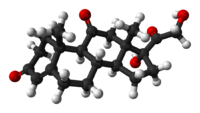Cortisone
| Cortisone | |
|---|---|
 |
|
 |
|
| IUPAC name | 17,21-dihydroxypregn -4-ene-3,11,20-trione |
| Identifiers | |
| CAS number | 53-06-5 |
| MeSH | |
| SMILES |
|
| Properties | |
| Molecular formula | C21H28O5 |
| Molar mass | 360.46 g/mol |
| Melting point |
220-224 °C |
| Except where noted otherwise, data are given for materials in their standard state (at 25 °C, 100 kPa) Infobox references |
|
Cortisone (pronounced /ˈkɔrtɨsoʊn/ or /ˈkɔrtɨzoʊn/ (ˈkôrtəˌsōn or -zōn)) (17-hydroxy-11-dehydrocorticosterone) is a steroid hormone. Chemically, it is a corticosteroid closely related to corticosterone.
Contents |
History
Cortisone was first discovered by the American chemist Edward Calvin Kendall while a researcher at the Mayo Clinic. He was awarded the 1950 Nobel Prize for Physiology or Medicine along with Philip S. Hench and Tadeus Reichstein for the discovery of adrenal cortex hormones, their structures, and functions. Cortisone was first produced commercially by Merck & Co..
Production
Cortisone is one of several end products of a process called steroidogenesis. This process starts with the synthesis of cholesterol which then proceeds through a series of modifications in the adrenal gland (suprarenal) to become any one of many steroid hormones. One end product of this pathway is cortisol. For cortisol to be released from the adrenal gland a cascade of signaling occurs. Corticotropin releasing hormone released from the hypothalamus stimulates corticotrophs in the anterior pituitary to release ACTH which relays the signal to the adrenal cortex. Here, the zona fasiculata and zona reticularis in response to ACTH secrete glucocorticoids, in particular cortisol. In the peripheral tissues cortisol is converted to cortisone by an enzyme called 11-beta-steroid dehydrogenase. Cortisol has much greater glucocorticoid activity than cortisone and thus cortisone can be considered an inactive metabolite of cortisol. However 11-beta-steroid dehydrogenase can catalyze the reverse reaction as well and thus cortisone is also the inactive precursor molecule of the active hormone cortisol. Cortisone is activated through hydrogenation of the 11-keto-group and is thus sometimes referred to as hydrocortisone.
Effects and uses
Cortisol, a glucocorticoid, and adrenaline are the main hormones released by the body as a reaction to stress. They elevate blood pressure and prepare the body for a fight or flight response.
Cortisone is sometimes used as a drug to treat a variety of ailments. It can be administered intravenously or cutaneously.
One of cortisone's effects on the body, and a potentially harmful side effect when administered clinically, is the suppression of the immune system. This could be the explanation for the apparent correlation between high stress and sickness. The suppression of the immune system may be important in the treatment of inflammatory conditions such as severe IgE-mediated allergies.
References
- Merck Index, 11th Edition, 2533
- Woodward R. B., Sondheimer F., Taub D. (1951). "The Total Synthesis of Cortisone". Journal of the American Chemical Society 73: 4057–4057. doi:.
- Ingle D. J. (1950). "The biologic properties of cortisone: a review". Journal of Clinical Endocrinology 10: 1312–1354.
See also
- Central serous retinopathy
- Corticosterol
External links
|
|||||||||||||||||